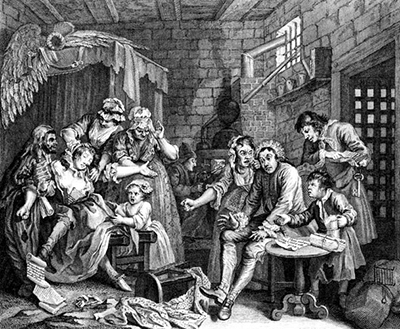Tom Incarcerated in Debtors' Prison by William Hogarth is the seventh in a series of eight paintings charting the fall of Tom Rakewell.
The series in its entirety is known as The Rake's Progress, and follows in storyboard format the rake in question, Tom Rakewell, as he fritters away his family's wealth on gambling, women and other debauched lifestyles. This ultimately sees Tom incarcerated in Fleet Prison (also known as the Debtors' Prison), and lastly, to the mental asylum of Bedlam. The series of paintings that make up The Rake's Progress were produced between 1732-1734 and were later made into engravings so that they could be published more widely in print format. By the time the rakish Tom arrives at the Debtor's Prison, all is pretty much lost for both him as a man and his inherited wealth. He has left behind by this point his first wife and child, the faithful Sarah, as well as his second wife, who is depicted as old and unattractive yet infinitely wealthy.
Now behind bars, Tom cannot reach either for assistance. Tom Incarcerated in Debtors' Prison shows not just other inmates, but even the jailer himself, trying to press Tom for money, and it seems Tom's avarice is now giving way to madness, with his eyes opened startlingly wide and all his limbs awkwardly outstretched. In the background, a telescope can just be seen along with fruitless attempts at alchemy. The painting is filled with a host of characters clawing over Tom, adding to the atmosphere of claustrophobia and pointing even more clearly towards his descent into madness. No character is still, all eyes and mouths are wide open with arms akimbo, and the implied movement and noise must have been cacophonous for the unfortunate rake of the title. The destination to follow this penultimate painting seems certain to be Bedlam by this point.
William Hogarth was an 18th Century English satirist, cartoonist and painter. The Rake's Progress was actually a follow up to his highly successful series, The Harlot's Progress, which followed a similar format but with a woman at its centre. The social commentary provided by both of these series are still vividly sublime in both their horror and humour. The Rake's Progress inspired a ballet and opera by the same name, and were so widely popular during their time that 'Hogarth's Law' was created, giving artist's greater control over reproduction and copyright.




